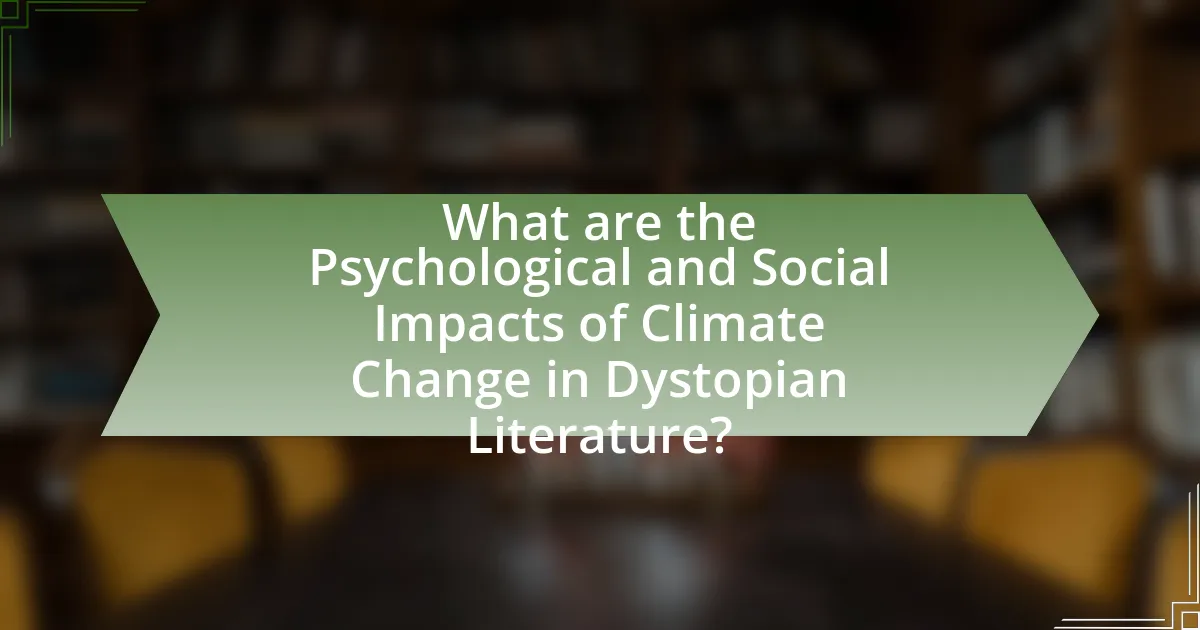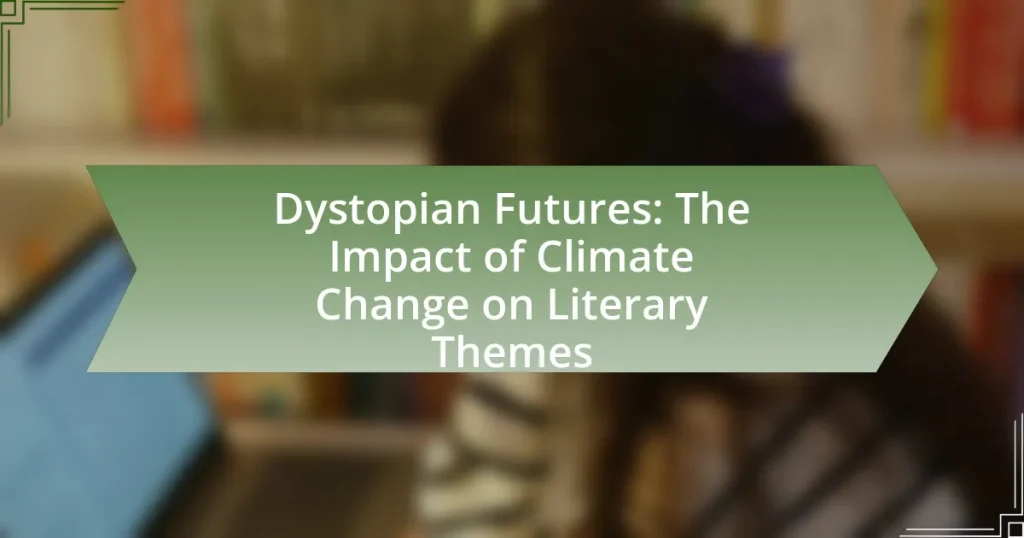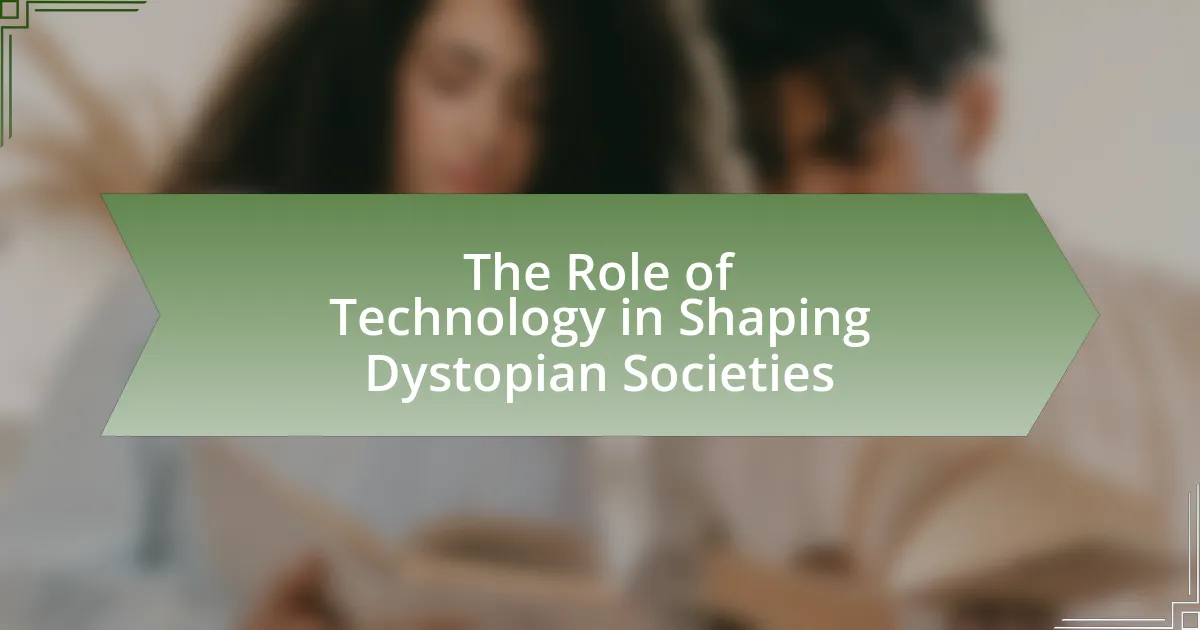Dystopian futures are speculative narratives that explore the consequences of climate change, depicting societies marked by environmental degradation, societal collapse, and oppressive control. This article examines how these narratives reflect societal fears about climate change, highlighting common themes such as resource scarcity, authoritarian governance, and human resilience. It also discusses the psychological and social impacts of climate disasters on characters, the role of hope in these stories, and how cultural perspectives shape the portrayal of climate change. Additionally, the article identifies key authors and recommended novels that address these themes, emphasizing the importance of engaging with dystopian literature to understand real-world climate issues and inspire action.

What are Dystopian Futures and Their Relation to Climate Change?
Dystopian futures are speculative scenarios that depict societies characterized by oppressive control, environmental degradation, and societal collapse, often as a result of climate change. These narratives illustrate the potential consequences of unchecked environmental destruction, such as extreme weather events, resource scarcity, and societal breakdown, which are increasingly relevant as climate change accelerates. For instance, the Intergovernmental Panel on Climate Change (IPCC) reports indicate that rising global temperatures and sea levels could lead to widespread displacement and conflict, themes commonly explored in dystopian literature. Such works serve as cautionary tales, reflecting real-world scientific predictions and urging society to address climate issues before they manifest in dire ways.
How do dystopian narratives reflect societal fears about climate change?
Dystopian narratives reflect societal fears about climate change by depicting extreme scenarios where environmental degradation leads to societal collapse. These narratives often illustrate the consequences of inaction on climate issues, such as resource scarcity, authoritarian governance, and widespread suffering. For instance, in novels like “The Road” by Cormac McCarthy, the bleak landscape serves as a metaphor for the potential future resulting from climate neglect, highlighting fears of survival in a world ravaged by ecological disaster. Additionally, the film “Snowpiercer” presents a world where climate change has rendered the planet uninhabitable, emphasizing societal divisions and the struggle for resources, which mirrors real-world concerns about inequality exacerbated by environmental crises. Such representations resonate with audiences, reinforcing the urgency of addressing climate change and reflecting deep-seated anxieties about humanity’s future.
What themes are commonly explored in dystopian literature related to climate change?
Common themes explored in dystopian literature related to climate change include environmental degradation, societal collapse, and human resilience. Environmental degradation often depicts the consequences of climate change, such as extreme weather events, loss of biodiversity, and resource scarcity, illustrating the dire state of the planet. Societal collapse frequently portrays the breakdown of social order due to climate-related disasters, leading to conflict over dwindling resources and the emergence of authoritarian regimes. Human resilience is highlighted through characters who adapt to harsh conditions, showcasing the struggle for survival and the fight against oppressive systems. These themes reflect real-world concerns about climate change and its potential impact on future societies.
How do authors use setting to depict climate-related dystopias?
Authors use setting to depict climate-related dystopias by creating environments that reflect the consequences of environmental degradation and societal collapse. For instance, in novels like “The Water Knife” by Paolo Bacigalupi, the arid landscapes and water scarcity illustrate the dire effects of climate change on human survival and social structures. These settings often feature extreme weather events, desolate urban areas, and altered ecosystems, which serve as a backdrop for exploring themes of resource conflict and human resilience. By vividly portraying these environments, authors emphasize the urgency of climate issues and provoke critical reflection on humanity’s relationship with nature.
Why is climate change a prevalent theme in contemporary dystopian literature?
Climate change is a prevalent theme in contemporary dystopian literature because it serves as a critical reflection of societal anxieties regarding environmental degradation and its consequences. Authors utilize climate change to explore themes of survival, societal collapse, and moral dilemmas, often depicting futures where ecological disasters lead to resource scarcity and social unrest. For instance, novels like “The Water Knife” by Paolo Bacigalupi illustrate a world ravaged by water shortages, highlighting the dire implications of climate inaction. This thematic focus resonates with readers as it mirrors real-world concerns about climate change, making it a powerful narrative device that prompts reflection on humanity’s relationship with the environment.
What historical events have influenced the portrayal of climate change in dystopian works?
The portrayal of climate change in dystopian works has been significantly influenced by historical events such as the Industrial Revolution, the 1970s energy crisis, and the scientific consensus on climate change established in the late 20th century. The Industrial Revolution marked the beginning of large-scale fossil fuel consumption, leading to environmental degradation and setting the stage for future dystopian narratives that explore the consequences of unchecked industrialization. The 1970s energy crisis heightened public awareness of resource scarcity and environmental issues, prompting authors to envision futures where these crises escalate into societal collapse. Furthermore, the establishment of the Intergovernmental Panel on Climate Change in 1988 and subsequent reports solidified the scientific understanding of climate change, inspiring works that reflect the urgency and potential catastrophic outcomes of global warming. These events collectively shaped the thematic elements of dystopian literature, emphasizing the dire consequences of humanity’s relationship with the environment.
How do cultural perspectives shape the depiction of climate change in dystopian futures?
Cultural perspectives significantly shape the depiction of climate change in dystopian futures by influencing the narratives, themes, and character responses to environmental crises. For instance, Western literature often portrays climate change as a catastrophic event leading to societal collapse, reflecting individualistic values and a focus on survival. In contrast, Indigenous narratives frequently emphasize harmony with nature and communal resilience, showcasing a more integrated approach to environmental stewardship. This divergence is evident in works like “The Road” by Cormac McCarthy, which embodies a bleak, survivalist outlook, versus “The Overstory” by Richard Powers, which highlights interconnectedness and ecological awareness. These cultural lenses not only affect the portrayal of climate change but also shape readers’ perceptions and responses to real-world environmental issues.

What are the Psychological and Social Impacts of Climate Change in Dystopian Literature?
The psychological and social impacts of climate change in dystopian literature often manifest as heightened anxiety, despair, and social fragmentation. Characters frequently experience mental health issues such as depression and post-traumatic stress disorder due to environmental degradation and societal collapse. For instance, in works like “The Road” by Cormac McCarthy, the pervasive sense of hopelessness reflects the psychological toll of a world ravaged by climate disaster. Socially, these narratives depict the breakdown of community structures, leading to isolation and conflict over dwindling resources, as seen in “Parable of the Sower” by Octavia Butler, where societal collapse fosters a survival-of-the-fittest mentality. These themes illustrate how climate change serves as a catalyst for both individual psychological distress and broader social disintegration in dystopian settings.
How do characters in dystopian stories respond to climate-induced crises?
Characters in dystopian stories typically respond to climate-induced crises with a mix of survival instincts, adaptation strategies, and moral dilemmas. For instance, in novels like “The Road” by Cormac McCarthy, characters exhibit extreme resilience and resourcefulness as they navigate a post-apocalyptic landscape ravaged by environmental collapse. They often face ethical choices, such as whether to help others or prioritize their own survival, reflecting the complex human responses to dire circumstances. Additionally, in “Parable of the Sower” by Octavia Butler, characters adapt to their harsh realities by forming communities and developing new belief systems, showcasing the human capacity for hope and innovation even in the face of overwhelming adversity. These narratives illustrate how climate-induced crises can lead to both the best and worst of human behavior, emphasizing themes of resilience, morality, and the struggle for survival.
What psychological effects do climate disasters have on protagonists in dystopian narratives?
Climate disasters in dystopian narratives often lead to profound psychological effects on protagonists, including trauma, anxiety, and a sense of hopelessness. These characters frequently experience post-traumatic stress disorder (PTSD) due to the catastrophic events they endure, which can manifest as flashbacks, nightmares, and severe emotional distress. Additionally, the constant threat of environmental collapse fosters chronic anxiety, as protagonists grapple with uncertainty about their future and the survival of their communities.
Research indicates that exposure to climate-related disasters can lead to increased rates of depression and feelings of isolation among individuals, as seen in studies conducted by the American Psychological Association, which highlight the mental health impacts of climate change on affected populations. Furthermore, the loss of familiar environments and social structures can result in a profound sense of grief and disconnection, compounding the psychological burden on these characters. Thus, the psychological landscape of protagonists in dystopian narratives is deeply shaped by the traumatic and anxiety-inducing nature of climate disasters.
How do social structures change in response to climate change in these stories?
Social structures in these stories change through the emergence of new hierarchies and the breakdown of traditional community bonds as a direct response to climate change. For instance, in many dystopian narratives, resource scarcity leads to the formation of elite groups that control access to essential resources, while marginalized populations face increased vulnerability and social isolation. This shift often results in heightened conflict and competition among different societal factions, as seen in works like “The Water Knife” by Paolo Bacigalupi, where water scarcity creates a brutal social order. Additionally, the collapse of governmental systems in response to climate disasters can lead to the rise of authoritarian regimes, further altering social dynamics and power structures.
What role does hope play in dystopian literature focused on climate change?
Hope serves as a crucial element in dystopian literature focused on climate change, acting as a catalyst for resilience and action among characters and communities. In narratives depicting bleak futures, hope often motivates individuals to confront environmental degradation and societal collapse, fostering a sense of agency and the possibility of change. For instance, in works like “The Overstory” by Richard Powers, characters find purpose in their connection to nature, illustrating how hope can inspire collective efforts to combat climate issues. This thematic focus on hope not only engages readers emotionally but also encourages reflection on real-world climate challenges, emphasizing the importance of optimism in driving environmental activism and innovation.
How do authors balance despair and hope in their narratives?
Authors balance despair and hope in their narratives by juxtaposing bleak scenarios with moments of resilience and human connection. This technique allows them to reflect the harsh realities of climate change while also highlighting the potential for recovery and adaptation. For instance, in works like “The Overstory” by Richard Powers, the narrative presents the devastating impact of environmental degradation alongside characters who find purpose in activism and community, illustrating that hope can emerge even in dire circumstances. This duality not only engages readers emotionally but also encourages a more nuanced understanding of the challenges posed by climate change, reinforcing the idea that despair and hope coexist in the human experience.
What examples illustrate the theme of resilience in the face of climate adversity?
Examples illustrating the theme of resilience in the face of climate adversity include the characters in “The Road” by Cormac McCarthy, who navigate a post-apocalyptic landscape while maintaining their humanity and hope for survival. Additionally, in “The Overstory” by Richard Powers, various characters demonstrate resilience by forming connections with nature and advocating for environmental preservation despite overwhelming odds. These narratives highlight the human spirit’s capacity to endure and adapt amidst dire climate challenges, showcasing resilience as a central theme in literature addressing climate change.

How Can Readers Interpret Dystopian Futures in the Context of Climate Change?
Readers can interpret dystopian futures in the context of climate change as cautionary tales that reflect the potential consequences of environmental neglect. These narratives often depict societies grappling with extreme weather events, resource scarcity, and societal collapse, illustrating the dire outcomes of inaction on climate issues. For instance, novels like “The Road” by Cormac McCarthy and “Parable of the Sower” by Octavia Butler showcase bleak landscapes and societal breakdowns that serve as warnings about the future if current climate trends continue. Such interpretations encourage readers to critically engage with real-world climate challenges and consider the urgency of sustainable practices to avert these dystopian scenarios.
What lessons can be learned from dystopian literature about climate action?
Dystopian literature teaches that urgent climate action is essential to prevent catastrophic societal collapse. Works like “The Road” by Cormac McCarthy illustrate the dire consequences of environmental neglect, showcasing a world ravaged by climate change where survival is a daily struggle. Additionally, “Parable of the Sower” by Octavia Butler emphasizes the importance of adaptability and community resilience in the face of ecological disaster, highlighting that proactive measures and collective efforts are crucial for survival. These narratives serve as cautionary tales, reinforcing the need for immediate and effective climate policies to avert the bleak futures they depict.
How do these narratives inspire real-world environmental activism?
Narratives depicting dystopian futures due to climate change inspire real-world environmental activism by illustrating the severe consequences of inaction. These stories often highlight the urgency of environmental issues, motivating individuals and communities to take action. For example, the novel “The Overstory” by Richard Powers emphasizes interconnectedness with nature, prompting readers to engage in conservation efforts. Additionally, films like “Interstellar” showcase potential future scenarios that resonate emotionally, leading to increased awareness and activism. Research indicates that storytelling can effectively influence public perception and behavior regarding environmental issues, as narratives create empathy and a sense of responsibility.
What critical perspectives can readers adopt when analyzing these texts?
Readers can adopt ecological, feminist, and Marxist critical perspectives when analyzing texts within the theme of dystopian futures impacted by climate change. The ecological perspective emphasizes the relationship between humans and the environment, highlighting how climate change shapes societal structures and individual behaviors in dystopian narratives. For instance, texts often depict environmental degradation as a catalyst for societal collapse, reflecting real-world concerns about climate change’s effects on ecosystems and human survival.
The feminist perspective can be applied to examine how gender roles and power dynamics are portrayed in the context of climate change, revealing how women and marginalized groups are disproportionately affected by environmental crises. This approach can uncover underlying social injustices and advocate for more equitable solutions in both literature and reality.
The Marxist perspective focuses on class struggle and economic factors, analyzing how capitalist systems contribute to environmental destruction and exacerbate inequalities in dystopian settings. This lens allows readers to critique the socio-economic structures that lead to climate-related disasters, drawing parallels to contemporary issues of environmental justice and economic disparity.
These critical perspectives provide a multifaceted understanding of how climate change influences literary themes, encouraging readers to engage with the texts on deeper levels.
What are some recommended dystopian novels that address climate change themes?
Some recommended dystopian novels that address climate change themes include “The Overstory” by Richard Powers, which explores the interconnectedness of human and environmental life, and “New York 2140” by Kim Stanley Robinson, depicting a future where rising sea levels have transformed urban landscapes. Additionally, “The Water Knife” by Paolo Bacigalupi presents a world ravaged by water scarcity due to climate change. These novels illustrate the profound effects of environmental degradation and the societal responses to such crises, highlighting the urgent themes of climate change in contemporary literature.
Which authors are known for their impactful portrayals of climate dystopias?
Authors known for their impactful portrayals of climate dystopias include Margaret Atwood, Kim Stanley Robinson, and Octavia Butler. Margaret Atwood’s “Oryx and Crake” explores genetic engineering and environmental collapse, highlighting the consequences of climate change. Kim Stanley Robinson’s “New York 2140” presents a future where rising sea levels reshape urban life, emphasizing the urgency of climate action. Octavia Butler’s “Parable of the Sower” depicts a society ravaged by climate-related disasters, illustrating the social and economic impacts of environmental degradation. These authors effectively use their narratives to reflect the dire realities of climate change and its potential future implications.
How can readers engage with these texts to deepen their understanding of climate issues?
Readers can engage with texts on climate issues by actively analyzing the themes, characters, and settings presented in dystopian literature. This engagement allows readers to draw parallels between fictional scenarios and real-world climate challenges, enhancing their comprehension of the complexities involved. For instance, novels like “The Overstory” by Richard Powers illustrate the interconnectedness of human actions and environmental consequences, prompting readers to reflect on their own ecological footprints. Additionally, participating in discussions or book clubs focused on these texts can facilitate deeper insights, as sharing diverse perspectives often uncovers new interpretations and understandings of climate-related themes.




